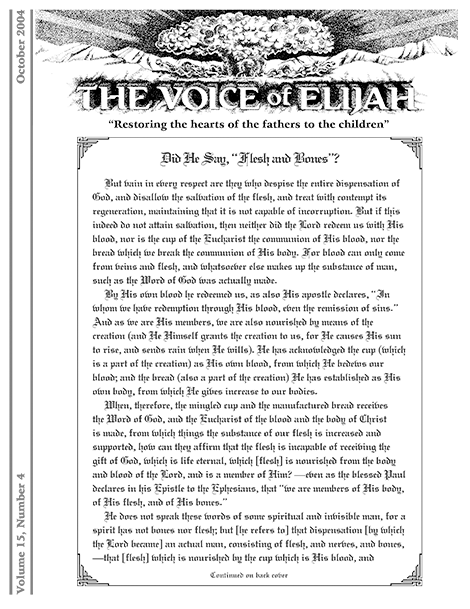Excerpt From eBook
There is only one requirement that God has laid on those who seek to participate in the Resurrection of the Righteous: They must demonstrate—in this age—an intense, burning desire to bear the same image and likeness of God that the righteous will bear in the age to come. That is, they must constantly seek to master the Truth of The Teaching that Jesus Christ is so that it transforms them (internally) into the same image and likeness that He bears:
If then you have been raised up with Christ, keep seeking the things above, where Christ is, seated at the right hand of God. Set your mind on the things above, not on the things that are on earth. For you have died and your life is hidden with Christ in God. When Christ, who is our life, is revealed, then you also will be revealed with Him in glory. Therefore consider the members of your earthly body as dead to immorality, impurity, passion, evil desire, and greed, which amounts to idolatry. For it is on account of these things that the wrath of God will come, and in them you also once walked, when you were living in them. But now you also, put them all aside: anger, wrath, malice, slander, {and} abusive speech from your mouth. Do not lie to one another, since you laid aside the old self with its {evil} practices, and have put on the new self who is being renewed to a true knowledge according to the image of the One who created him.
(Colossians 3:1–10)
In his letter to the church at Rome, Paul describes the transformation of the “inner man” as a “renewal” that goes on in the mind of the one growing in a knowledge of the Truth:
I urge you therefore, brethren, by the mercies of God, to present your bodies a living and holy sacrifice, acceptable to God, {which is} your spiritual service of worship. And do not be conformed to this world, but be transformed by the renewing of your mind, that you may prove what the will of God is, that which is good and acceptable and perfect.
(Romans 12:1–2)
The Greek verb that has been translated “transformed” in that passage is the same verb that we saw translated as “transformed” in this one:
Now the Lord is the Spirit; and where the Spirit of the Lord is, {there} is liberty. But we all, with unveiled face beholding as in a mirror the glory of the Lord, are being transformed into the same image from glory to glory, just as from the Lord, the Spirit.
(2 Corinthians 3:17–18)
If you are able to understand the parabolic imagery I have explained in this and all the other articles and books I have written, you should already be able to understand why Matthew and Mark used the same Greek verb that is translated “transformed” in those two passages to describe what happened to Christ in the following two passages as well:
And six days later Jesus took with Him Peter and James and John his brother, and brought them up to a high mountain by themselves. And He was transfigured before them; and His face shone like the sun, and His garments became as white as light. And behold, Moses and Elijah appeared to them, talking with Him.
(Matthew 17:1–3)
And six days later, Jesus took with Him Peter and James and John, and brought them up to a high mountain by themselves. And He was transfigured before them; and His garments became radiant and exceedingly white, as no launderer on earth can whiten them. And Elijah appeared to them along with Moses; and they were talking with Jesus.
(Mark 9:2–4)
In describing the “transformation” of True Believers into the image and likeness of God, the Apostle Paul used exactly the same verb that Matthew and Mark used to describe the transfiguration of Jesus. He did that because he knew that he was parabolically describing precisely the same phenomenon.
Larry Dee Harper, In the Image and Likeness of God, pp. 38–40
Newsletter Details
| Digital Copy | Free |
|---|---|
| Hard Copy | $1.50 |
| Author | Larry Dee Harper |
| Pages | 41 |
| Publisher | The Elijah Project |
| Released | 2005 |
| Edition | First edition |
| Language | English |
The Truth is Available
Check Out the Online Library
Browse through our library of newsletters and booklets—absolutely free!
Start Reading Now


